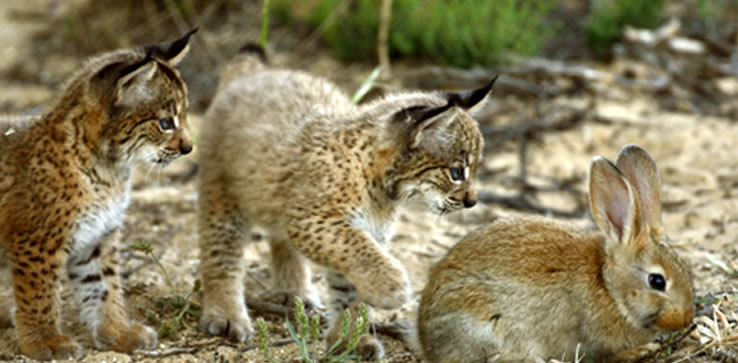
 EX-SITU PROGRAM
EX-SITU PROGRAM
Captive husbandry is based on interdisciplinary input from a variety of animal-care fields, such as nutrition, behaviour, genetics, physiology and veterinary medicine, together with the systematic use of the scientific method. One of the Programme’s key husbandry challenges is to strike a balance between fostering natural behaviours in captivity (hunting, territoriality, social interactions, etc.) and creating a stress-free environment where animals are more prone to mate. For this reason, the Breeding Programme favours naturalistic enclosures and promotes natural behaviours via environmental enrichment. In order to get important information about the animals (such as their body mass or determining whether or not the females are pregnant), certain training techniques are being used. Some of these include obtaining regular weights by having the lynx step on a measuring scale. Such techniques are designed to avoid using invasive methods, which would stress the animals, and they also serve as a way to strengthen the trust between the animals and their keepers. Special care is taken to avoid domestication of captive lynxes, although this becomes a greater challenge in the case of hand-reared, abandoned cubs.

Lynx behaviour and activity patterns are also being carefully observed by a round-the-clock video surveillance system, which provides a great deal of information on conducts that could not easily be learned through observations in the wild, such as the ontogeny of predatory behaviour or the evolution of the weaning process. Among other things, we have learned that mating behaviour in the Iberian lynx follows a similar pattern as that of other felids. Breeding season in captivity mostly takes place throughout January and February, with most births occurring in March and April, as it is the case in the wild. The actual mating period lasts between two and three days during which lynxes copulate an average of 28 times (range: 13-65; n=460 copulatory bouts in 21 pairs). Gestation period, counted from the time of the first copulation, ranges from 63-66 days (n = 12). All parturitions that have occurred before 61 gestational days (n=4) have resulted in the birth of either dead or weak and not completely developed young, which were considered premature. Although variation between individuals is very high, most females are very consistent regarding their own timing to enter estrous and regarding the number of days they are gravid.
Labour during whelping (regarded as the time lapsed between the first visible contractions until the delivery of the last offspring) varies widely between females, with some of them delivering each young within 10-15 min intervals while others taking up to 9 hours between the delivery of each offspring. Primiparous females have a higher rate of failure to raise their young than multiparous ones. Our video-surveillance system permits early detection of problems, which has resulted in the rescue of several Iberian lynx cubs that were hand-raised after being abandoned by their first-time mothers.
This non-intrusive surveillance system has also allowed us to identify the existence of a sensitive period when Iberian lynx cubs become highly competitive to the point of siblicide. Spontaneous aggression erupted at 44 days of age in the first Iberian lynx litter born in captivity. The largest cub (a female) in a litter of three was killed by a brother who delivered lethal bites to the larynx and skull. Agonistic behaviour has been observed in nine of eleven subsequent Iberian lynx litters of two or more cubs, with the most intensive fighting occurring around the 7th post-natal week. This same phenomenon has been observed in the Eurasian lynx by Russian scientists at the Tcherngolovka facility who recorded aggressive behaviour in 16 of 31 litters, with deaths occurring in four cases. The authors indicate that the highest prevalence of agonistic behaviour in Eurasian lynx cubs occurred at 36 to 64 days of age, with the greatest frequency during the seventh post-natal week. Although siblicide in Iberian lynx has not been directly observed in nature, a 1-month-old cub was found in the wild in 2003 with severe injuries compatible with bites from another cub. It may also be relevant that free-ranging Iberian lynxes generally give birth to three cubs, but 70% of the females are usually observed with only two young after approximately three months post-parturition. Sibling aggression in Iberian lynx has influenced programme husbandry as staff must be vigilant and prepared to break up aggressive bouts during the sensitive period.





